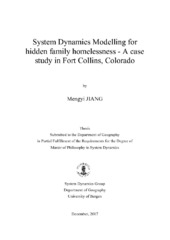System Dynamics Modelling for hidden family homelessness - A case study in Fort Collins, Colorado
Master thesis
Permanent lenke
https://hdl.handle.net/1956/17311Utgivelsesdato
2017-12-19Metadata
Vis full innførselSamlinger
- Department of Geography [634]
Sammendrag
Family homelessness is a long-lasting social problem and causes widespread concerns in the United States and throughout the world. Substantial efforts have been made to lift the homeless families out of the vulnerable situation and into opportunities. Despite that the outcomes of these efforts were very remarkable, it is argued that the population size of the hidden homeless families (HHF) - families living temporarily in someone else’s residences - are growing. These HHF have not received enough attention from the public and, therefore, lack resources to overcome the housing difficulty. In this study, by focusing on the City of Fort Collins, Colorado, I applied the System Dynamics Modelling approach in order to 1) unravel the factors that resulting in the growing number of HHF, 2) predict possible changes of the HHF population size in the future under the “business-as-usual” scenario and the “budget-reduction” scenario, and 3) propose feasible strategies in the form of a policy model to address the problem. The results suggested that the increase of the stock of HHF can attributed to the unbalance between its total outflow (mainly constrained by the capacity of the assistance programs, especially the availability of the housing choice vouchers and the number of landlords willing to participate in the assistance program) and its total inflow (mainly influenced by the number of evicted families that resulted from the rent burden and the adverse events for individuals). The number of HHF was predicted to increase at the same level under the two scenarios, but the second scenario is expected to have more pronounced effect on the families that are receiving vouchers. Based on the behaviour analysis, a particular strategy, increasing available vouchers by raising private funds, were designed in the model with a “wishful thinking” link to “connect the desired flow with the target flow”, and simulation results suggested that the HHF number will decrease as a result of the implementation of the strategies. This study concludes with a discussion of the implications for relevant public policies.
